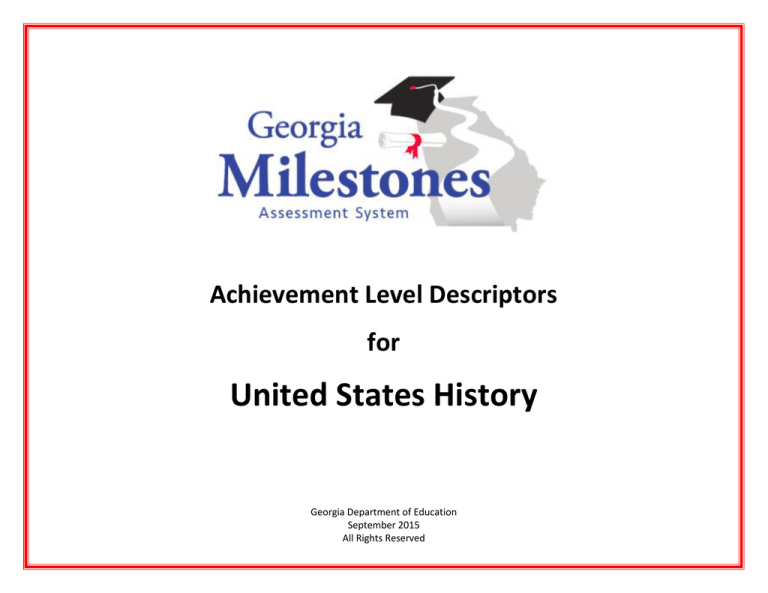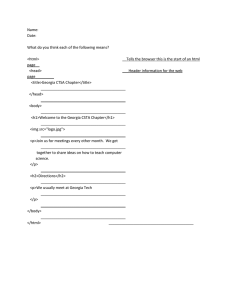
Achievement Level Descriptors
for
United States History
Georgia Department of Education
September 2015
All Rights Reserved
United States History EOC
Georgia End-of-Course: Social Studies
September 2015
Achievement Levels and Achievement Level Descriptors
With the implementation of the Georgia Milestones Assessment System, Georgia educators have developed four achievement levels to describe
student mastery and command of the knowledge and skills outlined in Georgia’s content standards. Most students have at least some
knowledge of the content described in the content standards; however, achievement levels succinctly describe how much mastery a student
has. Achievement levels give meaning and context to scale scores by describing the knowledge and skills students must demonstrate to achieve
each level.
The four achievement levels on Georgia Milestones are Beginning Learner, Developing Learner, Proficient Learner, and Distinguished Learner.
The general meaning of each of the four levels is provided below:
Beginning Learners do not yet demonstrate proficiency in the knowledge and skills necessary at this grade level/course of learning, as specified
in Georgia’s content standards. The students need substantial academic support to be prepared for the next grade level or course and to be on
track for college and career readiness.
Developing Learners demonstrate partial proficiency in the knowledge and skills necessary at this grade level/course of learning, as specified in
Georgia’s content standards. The students need additional academic support to ensure success in the next grade level or course and to be on
track for college and career readiness.
Proficient Learners demonstrate proficiency in the knowledge and skills necessary at this grade level/course of learning, as specified in
Georgia’s content standards. The students are prepared for the next grade level or course and are on track for college and career readiness.
Distinguished Learners demonstrate advanced proficiency in the knowledge and skills necessary at this grade level/course of learning, as
specified in Georgia’s content standards. The students are well prepared for the next grade level or course and are well prepared for college and
career readiness.
More detailed and content-specific concepts and skills are provided for each grade, content area, and course in the Achievement Level
Descriptors (ALDs). ALDs are narrative descriptions of the knowledge and skills expected at each of the four achievement levels and were
developed for each grade level, content area, and course by committees of Georgia educators in March 2015 and July 2015. The ALDs are based
on the state-adopted content standards.
ALDs show a progression of knowledge and skills for which students must demonstrate competency across the achievement levels. It is
important to understand that a student should demonstrate mastery of the knowledge and skills within his/her achievement level as well as all
content and skills in any achievement levels that precede his/her own, if any. For example, a Proficient Learner should also possess the
knowledge and skills of a Developing Learner and a Beginning Learner.
Georgia Department of Education
Page 2 of 6
All Rights Reserved
United States History EOC
Georgia End-of-Course: Social Studies
September 2015
POLICY ALDs
Beginning Learner
Beginning Learners do not yet
demonstrate proficiency in the
knowledge and skills necessary at this
grade level/course of learning, as
specified in Georgia’s content
standards. The students need
substantial academic support to be
prepared for the next grade level or
course and to be on track for college
and career readiness.
Developing Learner
Developing Learners demonstrate
partial proficiency in the knowledge
and skills necessary at this grade
level/course of learning, as specified in
Georgia’s content standards. The
students need additional academic
support to ensure success in the next
grade level or course and to be on
track for college and career readiness.
Beginning Learner
A student who achieves at the
Beginning Learner level demonstrates
minimal command of the course
standards. The pattern exhibited by
student responses indicates that
students are most likely able to
recognize that Europeans settled in
North America during the
seventeenth century;
identify mercantilism;
identify the primary causes of the
American Revolution;
identify territorial expansion in the
early decades of the new nation;
identify the U.S. Constitution;
identify the key events relating to
the causes of the Civil War;
identify industrial growth;
identify Reconstruction;
identify the origins of U.S.
involvement in World War I;
identify the Great Depression;
identify FDR and the New Deal;
Developing Learner
A student who achieves at the
Developing Learner level demonstrates
partial command of the course
standards. The pattern exhibited by
student responses indicates that
students are most likely able to
identify areas of European
settlement in North America during
the seventeenth century;
describe the Middle Passage and
growth of the African-American
population;
describe the primary causes of the
American Revolution;
identify the impact of territorial
expansion and population growth
in the early decades of the new
nation;
explain the Great Compromise and
the separation of powers;
identify growing north-south
divisions and westward expansion;
identify the key events and issues
relating to the causes and course
of the Civil War;
Proficient Learner
Proficient Learners demonstrate
proficiency in the knowledge and skills
necessary at this grade level/course of
learning, as specified in Georgia’s
content standards. The students are
prepared for the next grade level or
course and are on track for college and
career readiness.
Distinguished Learner
Distinguished Learners demonstrate
advanced proficiency in the
knowledge and skills necessary at this
grade level/course of learning, as
specified in Georgia’s content
standards. The students are well
prepared for the next grade level or
course and are well prepared for
college and career readiness.
RANGE ALDs
Georgia Department of Education
Proficient Learner
A student who achieves at the
Proficient Learner level demonstrates
proficiency of the course standards.
The pattern exhibited by student
responses indicates that students are
most likely able to
describe areas of European
settlement in North America during
the seventeenth century;
explain the way the economy of
British North America developed;
explain the primary causes of the
American Revolution;
describe specific events and key
ideas that brought about the
adoption and implementation of the
United States Constitution;
describe the impact of territorial
expansion and population growth
and the impact of this growth in the
early decades of the new nation;
describe the process of economic
growth and its regional and national
impact in the first half of the
nineteenth century;
Page 3 of 6
Distinguished Learner
A student who achieves at the
Distinguished Learner level
demonstrates advanced proficiency of
the course standards. The pattern
exhibited by student responses
indicates that students are most likely
able to
describe areas of European
settlement in North America
during the seventeenth century,
including reasons for settlement,
relations with Native Americans,
and role of location and place in
specific colonial regions;
trace the ways that the economy
and society of British North
America developed, including the
trans-Atlantic trade, the Middle
Passage, and the Great Awakening;
explain the primary causes of the
American Revolution and identify
the ideological, military, and
diplomatic aspects of the American
Revolution;
All Rights Reserved
United States History EOC
identify the major developments of
World War II;
identify technological
developments in the United States,
1945–1975;
identify the Cold War;
identify the civil rights movement,
1945–1970;
identify the political developments
in the United States between 1945
and 1970; and
identify social change movements.
Georgia Department of Education
Georgia End-of-Course: Social Studies
describe the expansion of
describe the relationship between
railroads;
growing north-south divisions and
westward expansion;
describe Reconstruction;
identify the key events, issues, and
identify the Progressive Era;
individuals relating to the causes,
identify the origins and impact of
course, and consequences of the
U.S. involvement in World War I;
Civil War, including the Kansasidentify some causes and
Nebraska Act, the Dred Scott case,
consequences of the Great
major generals and battles, and the
Depression;
Emancipation Proclamation;
describe Franklin Roosevelt’s New
identify legal, political, and social
Deal;
dimensions of Reconstruction,
identify the major developments
including the Freedmen’s Bureau,
and the domestic impact of World
Black Codes, and the Thirteenth
War II;
through Fifteenth Amendments;
identify the domestic impact of the
describe some effects of the growth
Cold War on the United States;
of big business and technological
describe the political
innovation after Reconstruction;
developments in the United States
describe important consequences of
between 1945 and 1970;
American industrial growth;
identify technological development
identify major efforts to reform
and economic growth in the United
American society and politics in the
States, 1945–1975;
Progressive Era;
identify dimensions of the civil
explain America’s evolving
rights movement, 1945–1970;
relationship with the world at the
identify social change movements
turn of the twentieth century;
and organizations of the 1960s;
describe the origins and impact of
and
U.S. involvement in World War I;
identify changes in national politics
identify key developments in the
since 1968.
aftermath of World War I;
describe the causes and
consequences of the Great
Depression;
describe Franklin Roosevelt’s New
Deal;
describe the major developments
and the domestic impact of World
War II;
Page 4 of 6
September 2015
explain specific events and key
ideas that brought about the
adoption and implementation of
the U.S. Constitution;
explain the impact of territorial
expansion and population growth
and the impact of this growth in
the early decades of the new
nation;
explain the process of economic
growth, its regional and national
impact in the first half of the
nineteenth century, and the
different responses to it;
explain the relationship between
growing north-south divisions and
westward expansion;
identify the key events, issues, and
individuals relating to the causes,
course, and consequences of the
Civil War, including the Dred Scott
case, Lincoln’s efforts to preserve
the Union, and the economic
disparity between the North and
the South;
identify legal, political, and social
dimensions of Reconstruction,
including Presidential and Radical
Republican Reconstruction and the
compromise of 1877;
describe the economic, social, and
geographic impact of the growth of
big business and technological
innovation after Reconstruction;
explain important consequences of
American industrial growth;
identify major efforts to reform
American society and politics in the
Progressive Era;
All Rights Reserved
United States History EOC
Georgia End-of-Course: Social Studies
describe the domestic and
international impacts of the Cold
War on the United States;
explain the political developments
in the United States between 1945
and 1970;
explain the impact of technological
development and economic growth
on the United States, 1945–1975;
identify dimensions of the civil
rights movement, 1945–1970;
identify the impact of social change
movements and organizations of
the 1960s; and
describe changes in national politics
since 1968.
Georgia Department of Education
Page 5 of 6
September 2015
explain the Roosevelt Corollary and
the creation of the Panama Canal;
explain the origins and impact of
U.S. involvement in World War I;
identify key developments in the
aftermath of World War I;
explain the causes and
consequences of the Great
Depression;
describe Franklin Roosevelt’s New
Deal as a response to the
depression and compare the ways
governmental programs aided
those in need;
identify the origins, major
developments, and domestic
impact of World War II, especially
the growth of the federal
government;
explain the domestic and
international impact of the Cold
War on the United States;
explain the impact of technological
development and economic
growth on the United States,
1945–1975;
identify dimensions of the civil
rights movement, 1945–1970,
including Brown v. Board of
Education and Martin Luther King’s
“I Have a Dream” speech;
All Rights Reserved
United States History EOC
Georgia Department of Education
Georgia End-of-Course: Social Studies
Page 6 of 6
September 2015
describe and assess the impact of
political developments between
1945 and 1970;
explain the impact of social change
movements and organizations of
the 1960s; and
describe changes in national
politics since 1968, including Nixon
and Watergate, Supreme Court
decisions on civil rights, and
changes in attitudes toward the
national government.
All Rights Reserved


